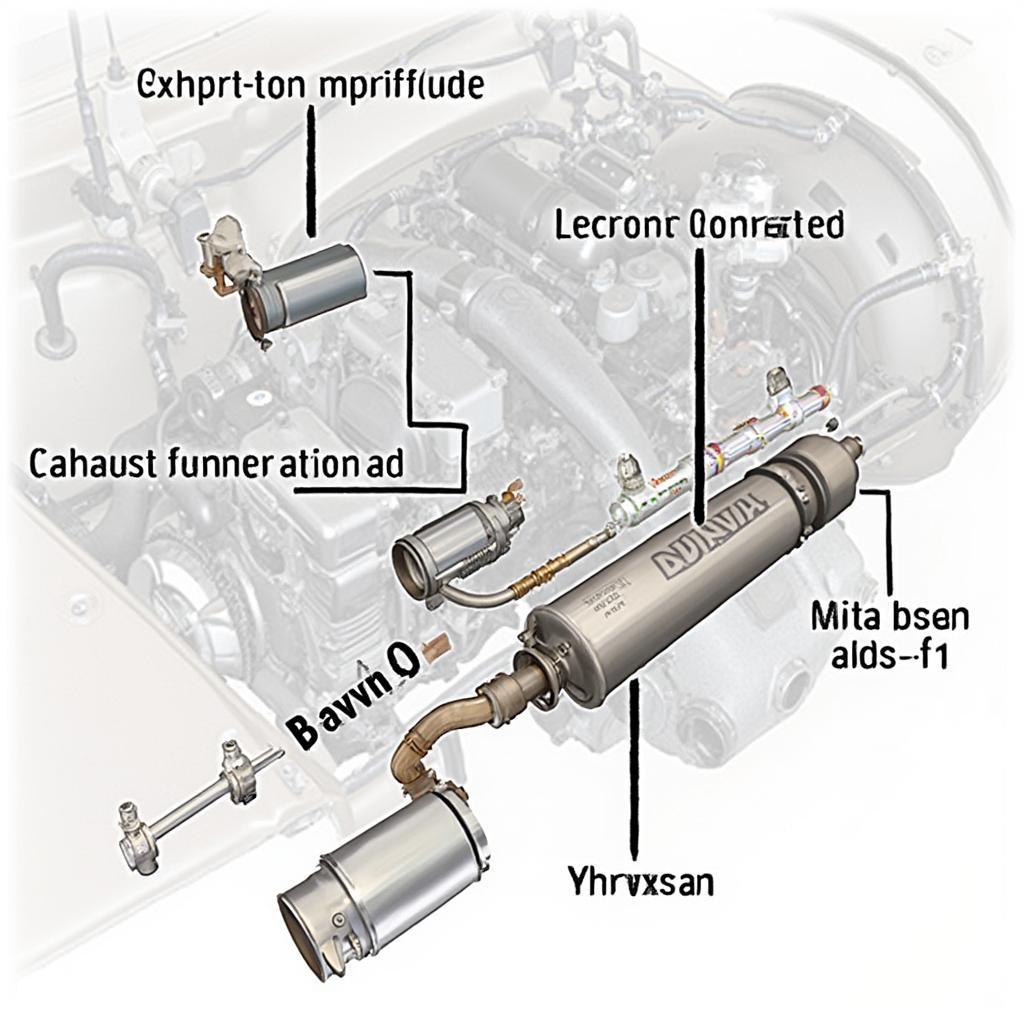The OBD2 error code P2096 indicates a problem with your vehicle’s exhaust system, specifically the post catalyst fuel trim system. This code can be a headache, but understanding what it means and how to address it can save you time and money. This article will delve into the intricacies of the P2096 code, providing you with a comprehensive guide to diagnose and potentially fix the issue.
What Does the OBD2 Code P2096 Mean?
The P2096 code stands for “Post Catalyst Fuel Trim System Too Lean Bank 1.” Let’s break this down. “Post Catalyst” refers to the part of the exhaust system after the catalytic converter. “Fuel Trim” is the adjustment your car’s computer makes to the fuel-air mixture to ensure optimal performance and emissions. “Too Lean” signifies that the mixture has too much air and not enough fuel. Finally, “Bank 1” refers to the side of the engine that contains cylinder number one.
This code essentially tells you that the oxygen sensor after the catalytic converter on Bank 1 is detecting a lean fuel mixture, even after the computer has tried to adjust it. This suggests a problem somewhere in the exhaust or fuel system.
Common Causes of P2096
Several issues can trigger the P2096 code. Some common culprits include:
- Faulty Oxygen Sensor: The post-catalytic converter oxygen sensor itself may be malfunctioning, sending inaccurate readings to the engine control unit (ECU).
- Exhaust Leaks: A leak in the exhaust system, particularly after the catalytic converter, can introduce fresh air and cause a false lean reading.
- Vacuum Leaks: Leaks in the engine’s vacuum system can disrupt the fuel-air mixture, leading to a lean condition.
- Fuel Pressure Problems: Low fuel pressure, possibly due to a failing fuel pump or clogged fuel filter, can prevent enough fuel from reaching the engine.
- Mass Airflow (MAF) Sensor Issues: A faulty MAF sensor can provide incorrect information about the amount of air entering the engine, leading to improper fuel mixture calculations.
Symptoms of a P2096 Code
While the check engine light is the most obvious symptom, you may also notice:
- Decreased fuel economy: A lean mixture can sometimes improve fuel economy slightly, but a persistent lean condition often indicates an underlying problem that could negatively impact mileage.
- Rough idle or hesitation: The engine may run rough or hesitate when accelerating.
- Engine misfires: In severe cases, a lean mixture can lead to engine misfires.
Diagnosing and Fixing the P2096 Code
Diagnosing the P2096 code requires a systematic approach. Here’s a suggested procedure:
- Verify the Code: Use an OBD2 scanner to confirm the P2096 code and check for any other codes that may be present.
- Inspect for Exhaust Leaks: Carefully examine the exhaust system, particularly the area after the catalytic converter, for any signs of leaks.
- Check the Oxygen Sensor: Test the post-catalytic converter oxygen sensor using a multimeter to ensure it’s functioning correctly.
- Inspect the Vacuum System: Check for vacuum leaks using a vacuum gauge or by spraying carb cleaner around potential leak points.
- Test Fuel Pressure: Use a fuel pressure gauge to verify that the fuel pump is delivering adequate pressure.
Expert Insights
“Often, the P2096 code is misdiagnosed as a faulty catalytic converter,” says Alex Ramirez, ASE Certified Master Technician. “It’s crucial to thoroughly inspect the oxygen sensor and exhaust system before replacing expensive components.” Another expert, Maria Sanchez, Automotive Engineer, adds, “Regular maintenance, including checking for vacuum leaks and ensuring proper fuel pressure, can prevent many common OBD2 codes, including the P2096.”
Conclusion
The OBD2 error code P2096 can be a complex issue, but with a thorough understanding of its meaning and potential causes, you can effectively diagnose and address the problem. Remember, using a reliable OBD2 scanner is crucial for accurate diagnosis. Don’t hesitate to seek professional help if you’re unsure about any step of the process, as a correct diagnosis can save you time and money in the long run, ensuring your vehicle runs smoothly and efficiently while preventing further damage.
FAQs
- Can I drive with a P2096 code? While you can usually drive with this code, it’s best to address it promptly to avoid potential further damage to your vehicle.
- Is a P2096 code serious? It can be. While it might not be an immediate emergency, ignoring it could lead to more significant problems.
- How much does it cost to fix a P2096 code? The cost varies depending on the underlying cause. A faulty oxygen sensor might be relatively inexpensive to replace, while a catalytic converter replacement can be significantly more costly.
- How can I prevent a P2096 code? Regular maintenance, including checking for vacuum leaks and maintaining proper fuel pressure, can help prevent this code.
- Can I fix a P2096 code myself? If you have some mechanical experience, you may be able to address some of the simpler causes. However, more complex issues may require professional assistance.
- What other codes are commonly associated with P2096? Related codes might include P0171 (System Too Lean Bank 1) or P0174 (System Too Lean Bank 2).
- Can a bad catalytic converter cause a P2096 code? While less common, a failing catalytic converter can sometimes contribute to this code.
Need assistance? Contact us via WhatsApp: +1(641)206-8880, Email: [email protected] or visit our office at 789 Elm Street, San Francisco, CA 94102, USA. Our 24/7 customer support team is ready to help.

